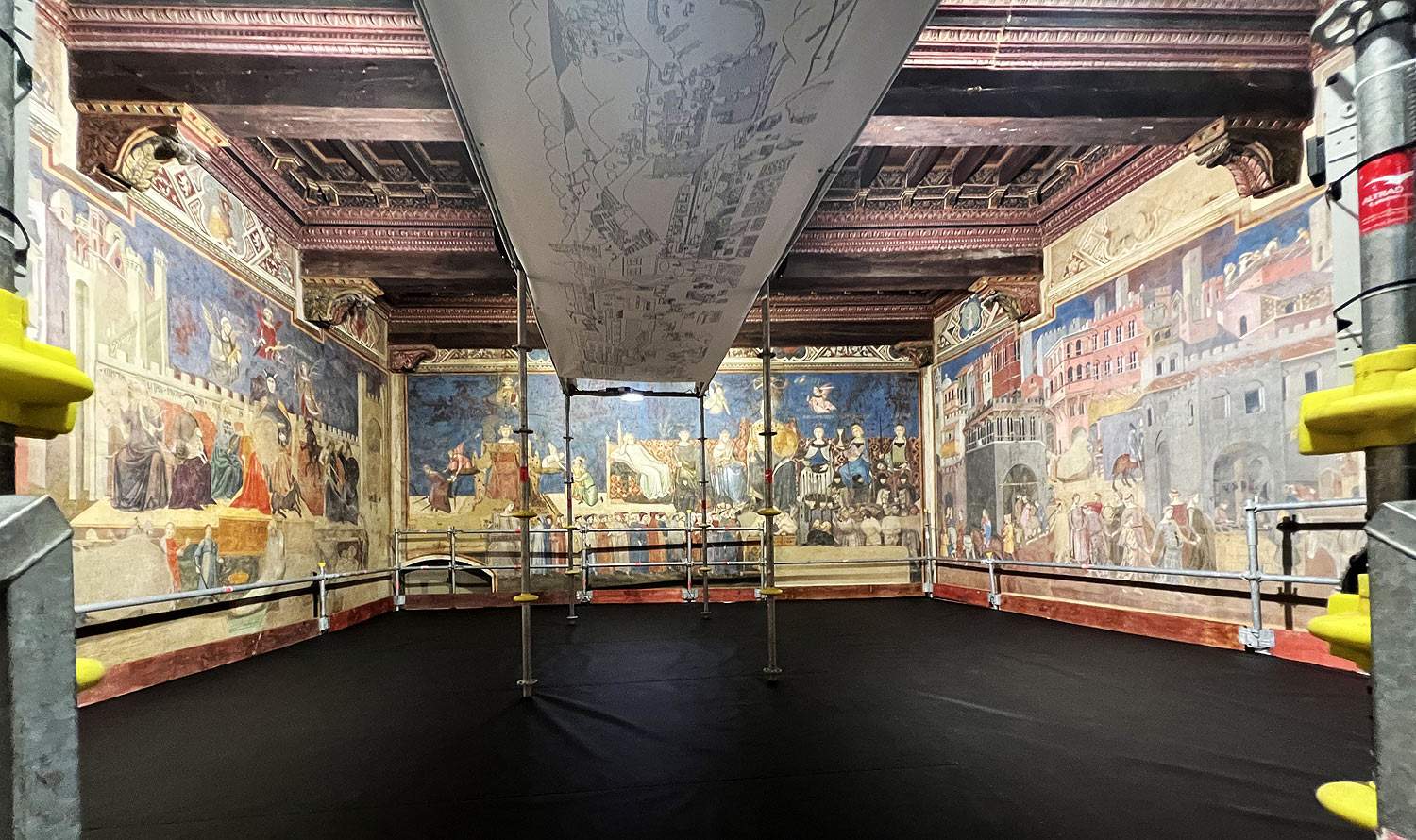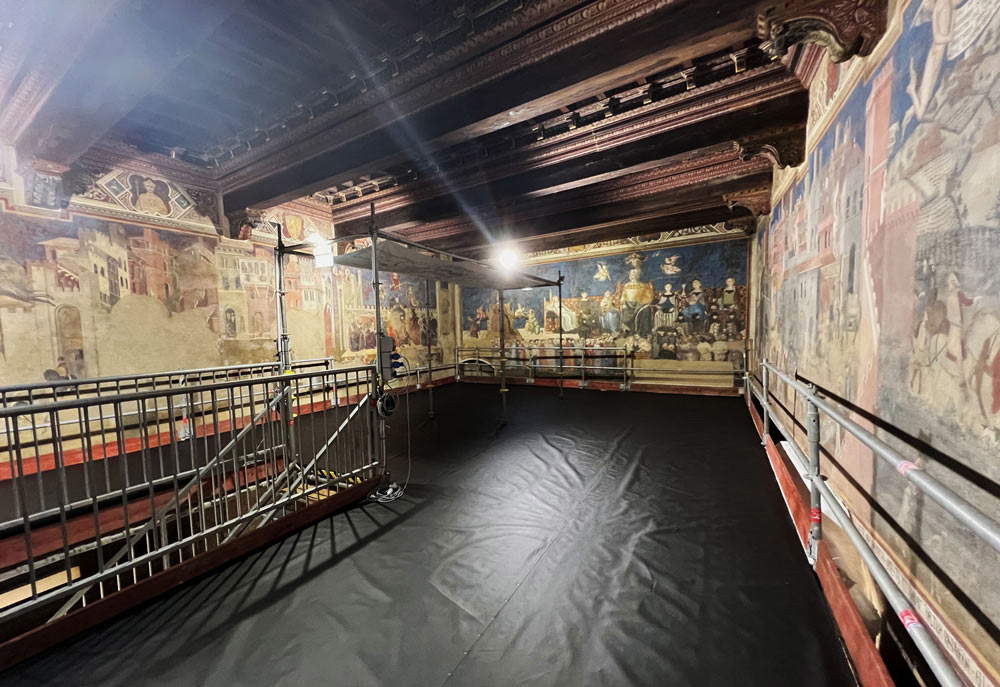Ahead, in Siena, of the restoration of the celebrated Good and Bad Government fresco cycle by Ambrogio Lorenzetti (Siena, 1290 - 1348): for the past few weeks the Sala del Buongoverno in the Palazzo Pubblico has been closed to the public for the work to get underway. And in October the site will be open to the public, who will be able to see experts at work up close, as well as the frescoes themselves. This is a unique opportunity to understand Ambrogio Lorenzetti’s painting technique and a chance to revitalize the entire Sienese museum circuit, which includes, among others, the Museo Civico and the Santa Maria della Scala complex, as well as the Pinacoteca Nazionale and the State Archives.
The frescoes with theAllegory and Effects of Good and Bad Government,, painted in 1338 by Ambrogio Lorenzetti in the Peace Room of the Palazzo Pubblico, are among the greatest masterpieces in the history of Italian art. With the works, which will improve the state of conservation of the work, this newly designed worksite, installed in March this year, designed not only as a laboratory for investigation and intervention by insiders, but also as a place of knowledge and study of art, will also become open and usable by the public.
As of next October, in fact, after the first diagnostic investigations, currently underway, and the beginning of the maintenance work behind closed doors, it will be possible to book special guided tours with restorers who will illustrate the work of the experts and the most appropriate actions to safeguard this supreme masterpiece. Not only that: by accessing the scaffolding, the pictorial cycle that helped make Siena famous in the world will be able to be admired from very close up, at human height, capturing the fascination of details and particulars, according to a privileged and extraordinary perspective.
“The project,” the Municipality of Siena informs, “is intended to be educational and informative with the intention of bringing attention back to the issue of protecting and caring for our artistic heritage, which never ceases to reveal itself and surprise. At the same time, the possibility of visiting the open construction site becomes an opportunity for tourism and cultural revitalization of the entire city museum circuit. In addition to the Palazzo Pubblico, home of the Civic Museum, with its highly prized frescoed rooms, the itinerary involves the Santa Maria della Scala complex, the ancient medieval hospital located on the Duomo hill, which also houses the National Archaeological Museum, the National Picture Gallery, a treasure chest of masterpieces of Sienese painting, and the State Archives, custodian of the precious collection of Sienese biccherne. All places of inestimable historical value, rich in treasures and works of art.”
 The
The The
TheThe intervention in the Room of Peace, also known as the Room of Good Government or the Room of the Nine, was necessary to monitor the condition of the painted surface, some thirty-five years after the conclusion of the last restoration, which, although it made it possible to halt the progressive degradation, which had manifested itself very early on, and recover all the richness and complexity of the frescoes. But it is not limited to an update of the conservative assessment and the causes of the alterations, with the use of the most up-to-date diagnostic instruments and methodologies, it is configured, as well, as a unique opportunity for in-depth study of Lorenzetti’s painting technique.
Through a multidisciplinary approach based on the synergistic work of various professionals: restorers, architectural archaeologists, chemists, petrographers, physicists and architects, in collaboration with specialists from the City of Siena, the organization of the artist’s articulated worksite is studied, tracing all the solutions adopted for the restitution of the ethical message entrusted to him, which is what made and makes the cycle of the Hall of Peace one of the greatest and most important in Western art.
The hall is the room where the rulers of the medieval city, commissioners of the famous civic and political manifesto that occupies its walls, met. The Nine, one of the principal magistracies of the Republic of Siena, were in office from 1287 to 1355, a period of political and economic heyday for the city. They commissioned Ambrogio Lorenzetti for the pictorial undertaking, as a man of vast culture and marked civic spirit (in 1347 he was elected to the council of the Paciari, before which he delivered a speech on “maintaining the peace and freedom of Siena”) and as an artist at the height of his maturity who, together with Duccio di Buoninsegna and Simone Martini, was a candidate to become one of the undisputed protagonists of the great season of Sienese Gothic painting.
In the pictorial cycle he depicts the two opposing forms of government of Democracy and Tyranny, and their opposing effects on the city, the countryside and the daily lives of the people. The painter stands as the main interpreter of the message of the Nine, creating a perfect synergy between art and politics. Giotto ’s lesson and the Sienese tradition blend harmoniously, giving shape to universally recognized ethical concepts that make the message of Good Government still very relevant today.
The City of Siena has launched the construction site in the Hall of Peace as the landing place of the project of diagnostics, enhancement and conservative maintenance of Ambrogio Lorenzetti’s masterpiece, which began in 2021, making use of the advice of professionals in the field and, with the collaboration of the University of Siena, the Institute of Applied Physics “Nello Carrara” of the CNR of Florence and the Superintendence SABAP of Siena Grosseto and Arezzo in addition to the support of the Rotary Club Montaperti, San Casciano-Chianti, Siena, Siena Est and Inner Wheel.
 |
| Siena, restoration work begins on Ambrogio Lorenzetti's Buongoverno |
Warning: the translation into English of the original Italian article was created using automatic tools. We undertake to review all articles, but we do not guarantee the total absence of inaccuracies in the translation due to the program. You can find the original by clicking on the ITA button. If you find any mistake,please contact us.